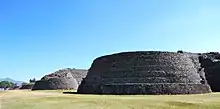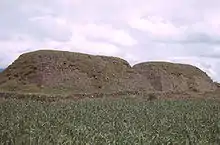Tzintzuntzán is a town of 3,500 people (2010) on Lake Patzcuaro in the state of Michoacan. Tsintsuntzan means 'where the temple of the messenger hummingbird god is located'. Onomatopoeia anyone?
Understand
History
Historical capital of at least one of the Purehpichan kingdoms whose magnificent yácata pyramids have been recovered despite the destruction under the Spanish conquest.
Get in
Drive over or take a bus from Patzcuaro or Quiroga.
By car
Get around
Walking works fine.
See
The yacatas for a small charge. Visit the historic church and convent (though a home to monks) that is being restored for an even smaller charge. The markets are known for fascinating cement sculptures, Christmas decorations and reed woven goods.

- 🌍 The archeological site of Tzintzuntzán. The ceremonial center of the pre-Columbian Tarascan state capital. Five reconstructed yácata pyramids line up looking out over Lake Pátzcuaro. The yácatas and other buildings rest on a large Grand Platform excavated into the hillside.
- The former monastery complex of San Francisco. The main attraction of the modern town is the former monastery, which was founded in the 16th century. The complex contains the Church of San Francisco, the Church of La Soledad, two open chapels and a large atrium, with much of the building material obtained from the nearby yacata pyramids that the Spanish destroyed.

- 🌍 Ihuatzio (7 km south-east of Tzintzuntzán). One of the most extensive and complex sites of the State of Michoacán. The archaeological remains are distributed in an approximate area of 50 hectares, only partially open to the public. It was an astronomical observatory and ceremonial center. Although they are relatively small, the pyramids dedicated to "Curicaueri" and "Xaratanga" are remarkable. First occupation: 900–1200 CE; second 1200–1530 CE.
Do
Festivals
The Night of the Dead around November 2 is quite busy and the cemeteries (pantheons) are magnificently dressed up in marigolds and attended to by families.
The Festival of Señor del Rescate is another important festival, and is celebrated during Carnival, just before Ash Wednesday (late February to early March).
Buy
Lead-free white clay, high temperature pottery, embroidered textiles with pre-Hispanic motifs, works with vegetable fibers.
Eat
Fish churipo, grain atole and corn products.